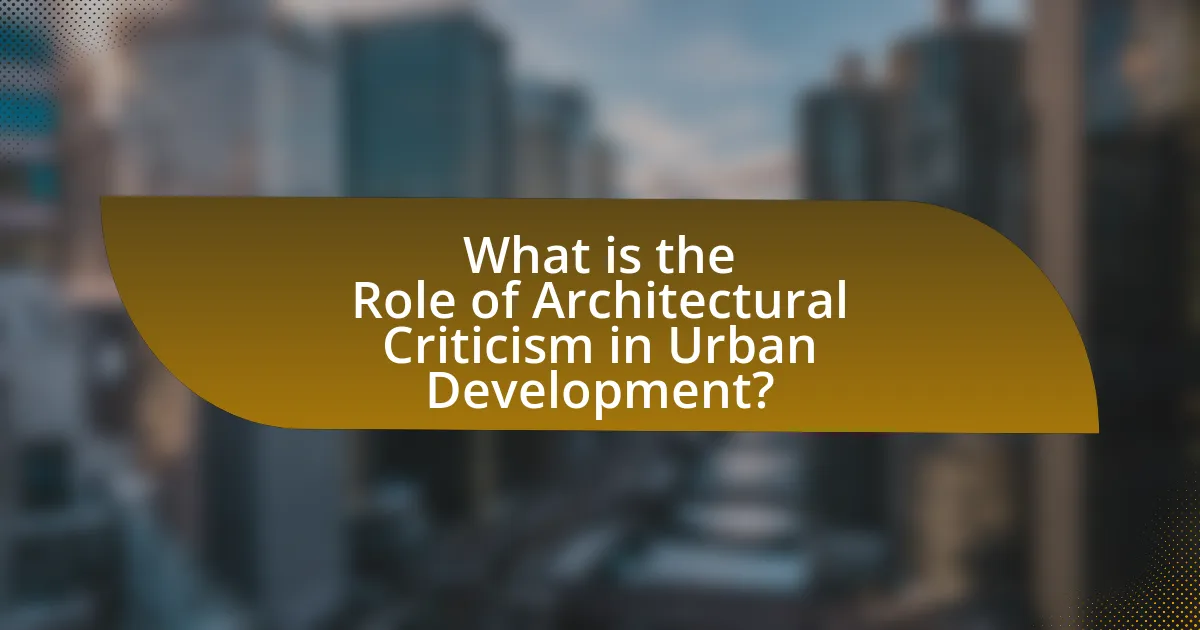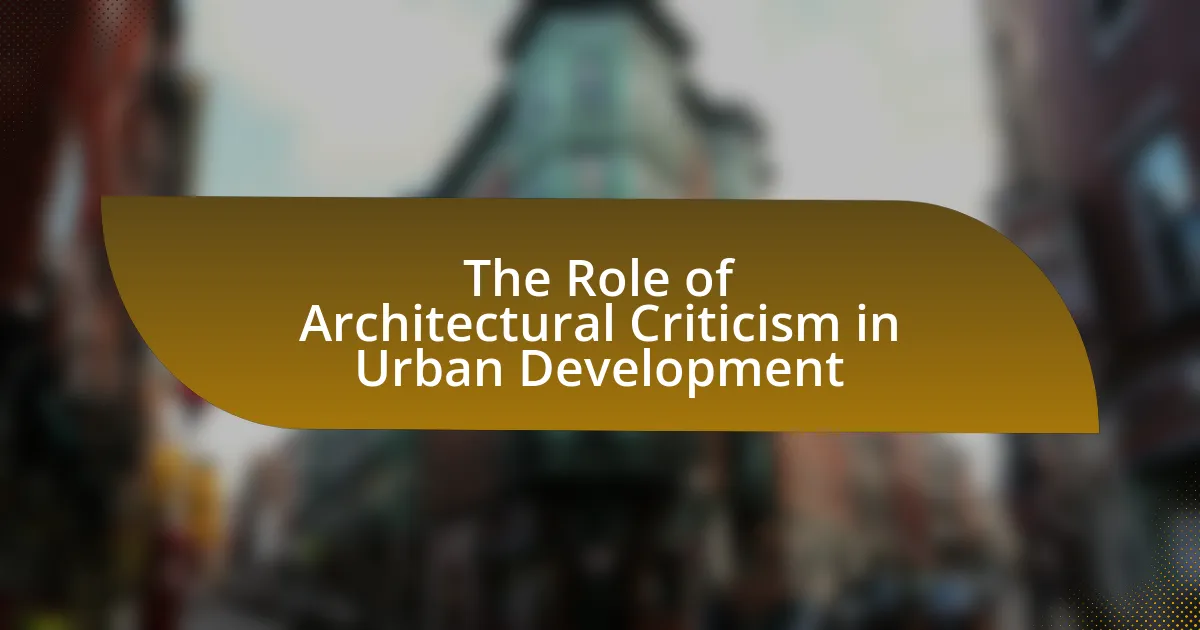Architectural criticism is a vital component of urban development, providing essential evaluations that influence design, functionality, and aesthetic quality of urban spaces. This article explores the impact of architectural criticism on urban planning, highlighting its role in shaping public discourse, promoting sustainability, and advocating for social equity. Key elements of architectural criticism include assessments of design aesthetics, functionality, and environmental sustainability, which collectively inform community needs and preferences. The article also examines the different types of criticism, the methodologies employed by critics, and the importance of engaging with diverse community perspectives to enhance the effectiveness of architectural evaluations in urban contexts.

What is the Role of Architectural Criticism in Urban Development?
Architectural criticism plays a crucial role in urban development by evaluating and influencing the design, functionality, and aesthetic quality of urban spaces. This form of critique provides essential feedback to architects, planners, and policymakers, ensuring that urban environments meet the needs of their inhabitants while also considering sustainability and cultural context. For instance, architectural critics often highlight successful projects that enhance community engagement and public spaces, such as the High Line in New York City, which transformed an abandoned railway into a vibrant urban park. This type of criticism not only fosters dialogue about architectural practices but also encourages accountability and innovation in urban design, ultimately shaping the future of cities.
How does architectural criticism influence urban planning?
Architectural criticism significantly influences urban planning by shaping public discourse and guiding design standards. Critics evaluate architectural projects, highlighting their social, cultural, and environmental impacts, which informs planners and policymakers about community needs and preferences. For instance, critiques of urban developments often lead to revisions in design to enhance accessibility and sustainability, as seen in the backlash against poorly designed public spaces that fail to serve diverse populations. This feedback loop ensures that urban planning is responsive to the evolving expectations of society, ultimately leading to more inclusive and functional urban environments.
What are the key elements of architectural criticism in urban contexts?
The key elements of architectural criticism in urban contexts include analysis of design aesthetics, functionality, social impact, and environmental sustainability. Architectural critics assess how buildings and urban spaces contribute to or detract from the urban fabric, considering factors such as visual coherence, user experience, and community engagement. For instance, the criticism of the High Line in New York City highlights its innovative use of space and positive social interaction, demonstrating how effective design can enhance urban life. Additionally, critics evaluate the environmental implications of architectural choices, emphasizing the importance of sustainable practices in urban development.
How does architectural criticism shape public perception of urban spaces?
Architectural criticism shapes public perception of urban spaces by influencing how communities interpret and value their built environments. Critics analyze design, functionality, and aesthetics, which can elevate public awareness and appreciation of architecture. For instance, when prominent critics highlight the social implications of a new urban development, it can lead to increased public discourse and engagement, as seen in the case of the High Line in New York City, where critical acclaim transformed it into a cultural landmark. This process can also affect policy decisions, as public opinion sways in response to critical evaluations, demonstrating the significant impact of architectural criticism on urban identity and community sentiment.
Why is architectural criticism important for sustainable urban development?
Architectural criticism is important for sustainable urban development because it evaluates and influences design practices that prioritize environmental, social, and economic sustainability. By critically assessing architectural projects, critics can highlight best practices and identify shortcomings, ensuring that urban developments align with sustainability goals. For instance, the American Institute of Architects emphasizes that effective criticism can lead to improved design outcomes that reduce carbon footprints and enhance community well-being. This evaluative process fosters accountability among architects and developers, ultimately contributing to more resilient and sustainable urban environments.
What impact does architectural criticism have on environmental considerations in urban design?
Architectural criticism significantly influences environmental considerations in urban design by shaping public discourse and guiding design practices towards sustainability. Critics often highlight the ecological impacts of architectural projects, advocating for designs that prioritize energy efficiency, resource conservation, and ecological balance. For instance, the criticism of urban sprawl has led to increased emphasis on sustainable practices such as green building certifications, which promote environmentally friendly materials and energy-efficient systems. This shift in focus is supported by studies indicating that cities with active architectural criticism tend to adopt more progressive environmental policies, as seen in cities like Portland, Oregon, where criticism has driven the integration of green spaces and sustainable infrastructure into urban planning.
How can architectural criticism promote social equity in urban development?
Architectural criticism can promote social equity in urban development by highlighting the needs and voices of marginalized communities in the design process. This form of critique encourages architects and urban planners to consider social justice as a fundamental aspect of their work, ensuring that developments serve diverse populations rather than perpetuating inequality. For instance, critiques that focus on accessibility, affordability, and community engagement can lead to more inclusive urban spaces. Research by the American Planning Association indicates that community involvement in planning processes results in projects that better reflect the needs of all residents, thereby fostering social equity.

What are the different types of architectural criticism in urban development?
The different types of architectural criticism in urban development include formal criticism, contextual criticism, and social criticism. Formal criticism focuses on the aesthetic and structural elements of buildings, evaluating design principles, materials, and spatial organization. Contextual criticism examines how a building interacts with its surroundings, considering historical, cultural, and environmental factors. Social criticism addresses the impact of architecture on communities, analyzing issues such as accessibility, inclusivity, and social equity. Each type of criticism plays a crucial role in shaping urban environments by influencing design decisions and public policy.
How do professional critics differ from public critics in their approach?
Professional critics approach architectural criticism with a focus on technical expertise and established criteria, while public critics often rely on personal experience and subjective opinions. Professional critics typically possess formal education in architecture or related fields, enabling them to analyze design elements, historical context, and functionality with a critical lens. In contrast, public critics may prioritize emotional responses and community impact, reflecting broader societal sentiments rather than technical assessments. This distinction is evident in the way professional critics often publish in specialized journals or platforms, whereas public critics might express their views through social media or community forums, emphasizing accessibility and relatability over academic rigor.
What methodologies do professional critics use in their evaluations?
Professional critics use a combination of qualitative and quantitative methodologies in their evaluations. Qualitative methodologies include observational analysis, where critics assess the aesthetic and functional aspects of architectural designs through site visits and personal experience. Quantitative methodologies often involve the use of metrics such as building performance data, user satisfaction surveys, and statistical analysis of architectural trends. These methodologies are supported by frameworks like the International Council on Monuments and Sites (ICOMOS) guidelines, which emphasize the importance of both subjective interpretation and objective measurement in architectural evaluation.
How does public opinion shape the discourse around urban architecture?
Public opinion significantly shapes the discourse around urban architecture by influencing design decisions, policy-making, and community engagement. Architects and urban planners often consider public sentiment to ensure that projects align with community values and needs, which can lead to more successful and accepted designs. For instance, public opposition to high-rise developments in certain neighborhoods can result in modifications or cancellations of projects, as seen in various cities where community forums and surveys have directly impacted architectural outcomes. This dynamic illustrates how public opinion acts as a critical feedback mechanism, guiding architects and developers to create spaces that resonate with the populace, thereby fostering a sense of ownership and belonging within urban environments.
What role does architectural criticism play in historical preservation?
Architectural criticism plays a crucial role in historical preservation by evaluating and advocating for the protection of significant architectural heritage. This form of criticism provides informed assessments that highlight the cultural, aesthetic, and historical value of buildings, influencing public opinion and policy decisions regarding preservation efforts. For instance, critics often analyze the impact of proposed developments on historic sites, thereby shaping the discourse around urban planning and conservation. By documenting and critiquing architectural practices, critics contribute to a broader understanding of the importance of maintaining historical integrity in urban environments, ultimately guiding stakeholders in making informed choices that honor the past while accommodating contemporary needs.
How does criticism influence the preservation of architectural heritage in urban areas?
Criticism significantly influences the preservation of architectural heritage in urban areas by shaping public discourse and policy decisions. When critics highlight the cultural, historical, and aesthetic value of specific structures, they can mobilize community support and raise awareness about the importance of preserving these assets. For instance, the preservation efforts for the historic buildings in cities like New York and Paris have often been bolstered by critical reviews that emphasize their architectural significance and the risks posed by urban development. Studies show that cities with active architectural criticism tend to implement stronger preservation policies, as seen in the establishment of landmark status for buildings that critics advocate for, thereby ensuring their protection against demolition or neglect.
What challenges do critics face in balancing modern development with historical integrity?
Critics face significant challenges in balancing modern development with historical integrity, primarily due to conflicting priorities between economic growth and preservation. Modern development often prioritizes efficiency, profitability, and contemporary aesthetics, which can lead to the demolition or alteration of historically significant structures. For instance, urban renewal projects frequently result in the loss of cultural heritage sites, as seen in cities like New York, where the destruction of Penn Station in the 1960s sparked widespread criticism and highlighted the need for better preservation practices. Additionally, critics must navigate public opinion, which can vary widely; some community members may favor new developments for their potential economic benefits, while others advocate for the preservation of historical sites. This dichotomy complicates the critics’ role, as they strive to advocate for sustainable development that respects historical context while addressing modern needs.

How can architectural criticism be effectively utilized in urban development projects?
Architectural criticism can be effectively utilized in urban development projects by providing informed evaluations that guide design decisions and community engagement. This form of criticism assesses the aesthetic, functional, and social implications of architectural designs, ensuring that projects align with community needs and urban context. For instance, critiques can highlight the importance of sustainable practices, as seen in the case of the High Line in New York City, where public feedback and expert analysis shaped its transformation into a successful urban park. By integrating architectural criticism into the planning process, stakeholders can foster a more inclusive dialogue, ultimately leading to developments that enhance urban environments and reflect the values of the community.
What best practices should critics follow when evaluating urban architecture?
Critics evaluating urban architecture should prioritize a comprehensive analysis that includes context, functionality, aesthetics, and sustainability. This approach ensures that the evaluation reflects the building’s impact on its environment and community. For instance, critics should assess how well the architecture integrates with its surroundings, considering historical significance and cultural relevance, as seen in the preservation efforts of historic districts in cities like New Orleans. Additionally, functionality must be evaluated by examining how the design meets the needs of its users, which can be supported by user feedback and occupancy rates. Aesthetic considerations should include the visual harmony of the structure with its urban landscape, while sustainability practices should be assessed based on energy efficiency and environmental impact, as highlighted by the LEED certification standards. By adhering to these best practices, critics can provide informed and constructive evaluations that contribute to the discourse on urban development.
How can critics engage with communities to enhance their evaluations?
Critics can engage with communities to enhance their evaluations by actively participating in local discussions and forums. This involvement allows critics to gather diverse perspectives and insights directly from community members, which can inform their assessments of architectural projects. For instance, critics can attend town hall meetings or community workshops, where they can listen to residents’ concerns and aspirations regarding urban development. Research indicates that community engagement leads to more nuanced evaluations, as critics who incorporate local voices often produce analyses that reflect the social and cultural context of the area. By fostering dialogue and collaboration, critics not only enrich their evaluations but also contribute to a more inclusive approach to architectural criticism.
What tools and resources are available for effective architectural criticism?
Effective architectural criticism utilizes various tools and resources, including academic journals, architectural magazines, online platforms, and critique workshops. Academic journals such as the Journal of Architectural Education provide peer-reviewed articles that analyze architectural theory and practice, while magazines like Architectural Digest and Dezeen offer insights into contemporary design trends and critiques. Online platforms, including social media and blogs, allow for broader discussions and immediate feedback from diverse audiences. Additionally, critique workshops and seminars foster collaborative evaluation of architectural works, enhancing critical skills through peer interaction. These resources collectively support informed and nuanced architectural criticism, essential for urban development discourse.
What are the common pitfalls in architectural criticism related to urban development?
Common pitfalls in architectural criticism related to urban development include a lack of contextual understanding, oversimplification of complex issues, and failure to engage with diverse community perspectives. Critics often overlook the historical, social, and economic contexts that shape urban environments, leading to assessments that do not reflect the realities of the communities involved. For instance, critics may focus solely on aesthetic elements without considering the functionality and social implications of a design, which can result in misleading evaluations. Additionally, many critics may not incorporate feedback from local residents, thereby missing crucial insights that could inform a more nuanced critique. This disconnect can perpetuate designs that do not meet the needs of the community, ultimately undermining the effectiveness of urban development initiatives.
How can biases affect the evaluation of urban architecture?
Biases can significantly distort the evaluation of urban architecture by influencing perceptions and judgments about design quality, functionality, and cultural relevance. For instance, personal biases related to aesthetics, socioeconomic status, or cultural background can lead critics to favor certain architectural styles over others, often disregarding the context or community needs. Research indicates that architectural critics may unconsciously prioritize designs that align with their own preferences, which can skew public discourse and policy decisions regarding urban development. This phenomenon is evident in studies that show how urban spaces designed with modernist principles are often celebrated, while traditional or vernacular architectures may be undervalued, despite their historical and cultural significance.
What strategies can critics employ to avoid these pitfalls?
Critics can employ several strategies to avoid pitfalls in architectural criticism, including maintaining objectivity, grounding opinions in factual evidence, and engaging with diverse perspectives. Objectivity helps critics assess designs without personal biases, ensuring that evaluations are fair and balanced. Grounding opinions in factual evidence, such as historical context or architectural principles, enhances credibility and supports arguments with concrete data. Engaging with diverse perspectives allows critics to consider various viewpoints, enriching their analyses and fostering a more comprehensive understanding of the architectural landscape. These strategies collectively contribute to more effective and responsible architectural criticism in urban development.
What practical tips can enhance the impact of architectural criticism in urban development?
To enhance the impact of architectural criticism in urban development, critics should engage with diverse community stakeholders to ensure that their perspectives are represented. This engagement fosters a more inclusive dialogue, allowing criticism to address the needs and desires of the community effectively. Additionally, critics should utilize visual aids and data-driven analysis to support their arguments, making complex ideas more accessible and understandable. For instance, incorporating site-specific case studies can illustrate the potential consequences of architectural decisions, thereby grounding criticism in real-world implications. Furthermore, critics should maintain a constructive tone, focusing on solutions rather than merely highlighting flaws, which encourages collaboration between architects, developers, and the community. This approach not only strengthens the relevance of architectural criticism but also promotes a more thoughtful and responsive urban development process.
